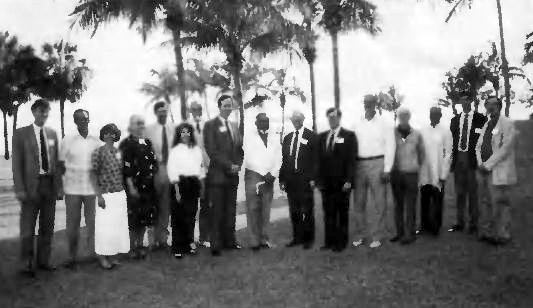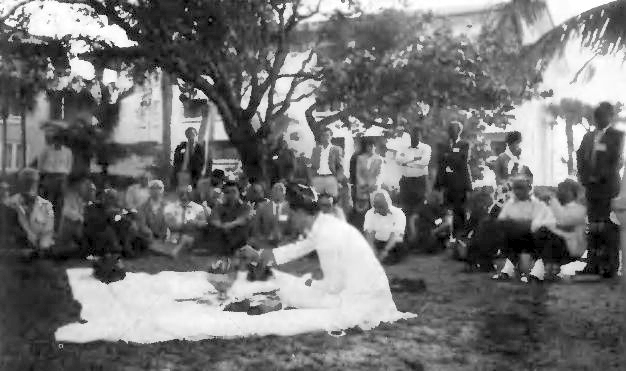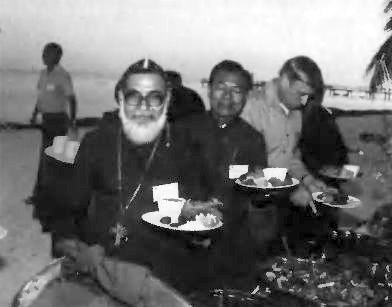![]()
The Words of the Gehring Family
|
|
The Words of the Gehring Family |

Some
of the distinguished speakers and organizers of the Sixth God
Conference. Left to right: Franz Feige, Frederick Sontag, Susan
Bryant, Kendra Smith, M. Darryl Bryant, Nora Bolin, Houston Smith,
Thomas Walsh, Ninian Smart, Robert Scharlemann, Jonathan Wells,
Robert Carter, George Tavard, Francis D'Sa, Homi Dhalla, and Gene
James.
On April 16-22, 1988, the sixth conference on "God: The Contemporary Discussion," sponsored by the New Ecumenical Research Association (New ERA), a project of IRF, was held at the Marriott Casa Marina Resort in Key West, Florida, a semi-tropical island marking the southernmost point in the United States. As always, the God Conference, as it is popularly known, attracted prominent scholars in religion and related fields from all over the world. Many and varied insights, beliefs, and ideals were shared in the hopes of promoting religious harmony and cooperation.
The God Conference's importance to the world was clearly illustrated by Rev. Chung Hwan Kwak, the executive director of IRF, in his closing remarks. He cited that lasting peace and happiness can be created only by those who have a religious outlook as a worldview. Unlike politicians, who are seeking to further the interests of a particular group, religious leaders share a common center -- God -- which gives them a foundation for creating a unity that is impartial and universal. Therefore, those helping to create inter-religious harmony hold the key to world peace. The God Conference, by gathering ecumenically- conscious scholars and providing a setting for educational and spiritual exchange, plants seeds for new approaches to solving inter-religious conflicts on local, national, and global levels.

Morning
worship given by a Zoroastrian priest.
Each person comes from a particular cultural and religious background and has interpreted the reality of God from his or her own perspective. The monotheistic traditions of Judaism, Christianity, and Islam believe that the Creator is a personal God and that we, as His servants or children, are capable of finding true happiness working as brothers and sisters in a life devoted to His service. In contrast, the goals of various forms of Buddhism are not to serve a personal God but to find the inner path to liberation. This path to spiritual liberation is found within oneself, and meditation, as well as selfless service to others, are crucial vehicles used to achieve it. In this contrast, one can see that the paths taken by the various faiths are unique yet interrelated.
The challenge for each of the participants at the God Conference is to attain a more universal understanding of and appreciation for God in His various expressions. I can illustrate this kind of challenge with a personal example. As a Westerner with a Christian background, my understanding of God's forgiveness and grace differs greatly from that of my Japanese wife, in whose cultural and religious background the concept of grace is largely missing. Conversely, because of the role loyalty and filial piety play in the everyday life of the Japanese people, my wife's insights into the concept of loyally and its importance is much deeper than mine. Through our interaction, we could begin to look through each other's eyes, and our understanding of the true living God could expand.
In addition to religious diversity, each culture of the world sees the realm of the sacred in different shades and hues. For example, to most East Indians the cow is a sacred symbol to be venerated because of it quality of contentment, a sublime virtue in the predominantly Hindu culture. Because of its sacredness, it must never be eaten. To the Korean farmer, the cow is also highly respected, but for very different reasons: It offers all parts of itself to serve man. The milk is used as a drink, the hide becomes clothing, and the flesh gives food to sustain life. To use another illustration, when a Kenyan herdsman reads the tales and trials of the herdsmen of the Bible, such as Jacob and David, his insights may often be deeper and more stirring than those of a Western theologian, because the stories relate directly to his own cultural experience.
I am convinced that when sincere scholars and seekers come together in dialogue, fellowship, and worship with their peers from different religious and cultural traditions, a great broadening and deepening of understanding can occur. With the attainment of a more universal religious outlook, these scholars can become advocates for the ideal of religious cooperation among all the earth's peoples.

The
closing banquet on the beach -- "The good food and friendly
company helped everyone unwind."
The God Conference stimulates the participants to go beyond themselves. Picture yourself there. One morning you attend a worship service given by a Zoroastrian priest. On your right is a Tibetan Buddhist monk; on your left is an African philosopher. A Jewish rabbi and a Christian theologian sit in front of you, while the sound of an ancient sacred Zoroastrian chant fills the air. Each morning you attend a different kind of worship service, and each day you hear and discuss a vast range of ideas in your groups. In one group an Indian participant describes the physical and spiritual aspects of a pilgrimage to a Hindu holy shrine. In another group, a Sikh leader responds to the challenge that Darwin's theory of evolution presents to his religious worldview. Over a meal, you quiz two South African theologians, one black and the other white, concerning the plight of their country. Both express a burning desire to help create the changes necessary to avoid violent confrontation in their nation. These multiple daily experiences teach you to expect the unexpected. The dynamics of the interrelationships make the exchanges of the conference much more than scholarly mutualities. The conference becomes a microcosm of humankind's sincere scholarly quest for the Ultimate, the Divine; and it is because of this quest that the window to the Divine becomes clearer.
The God Conferences have been continually breaking new ground in the field of inter-religious dialogue.
Papers presented at the conference are academically strong and draw strength from their diversification. Thirteen books centered on the themes of the conferences have already been produced by New Era Books and Paragon House Publishers. These books are reaching an audience of scholars and interested religionists from every continent. Many of the papers presented at the conferences can also be read in the IRF journal Dialogue and Alliance or in the IRF Newsletter.
This year's God Conference, convened under the experienced chairmanship of Dr. Robert Scharlemann, Commonwealth Professor of Religious Studies at the University of Virginia, attracted 114 participants. The conference themes covered such provocative topics as: "Contemporary Arguments or Proofs Concerning the Existence of God," "The One, the Many, the Other, the Divine," "Cultural Gods and Gods in Culture," "Pilgrimage and the Quest of the Divine," "Self, Not-Self, and the Ultimate," and "God and Evolution."
Among the features of the conference was a special plenary session presentation by the noted Hindu scholar Dr. Jarava Mehta of Harvard University. His presentation "Krishna: God as Friend" provided listeners with insights into the heart of some of the most famous stories in Hinduism. This conference also marked a transition in conference leadership. Dr. Jonathan Wells, the former director of IRF, officially ended his memorable tenure as project director of the God Conference, while Dr. Franz Feige, a recent graduate of Drew University, stepped into his vacated position. This was ceremonially marked during the closing session of the conference.
The God Conference can test each individual in difficult ways, for often one's ideas, understandings, and even beliefs can be put to question. At times during the week together, the participants felt the pressure that the demands of the conference presented. However, they and their families were given time to relax with the conference staff at the closing banquet.
The closing banquet was held on the beach of the Marriott Hotel. The comfortably warm, star-filled night, good food, and friendly company helped everyone unwind. During those final hours together, the rhythmic sounds of reggae music lifted the participants off their chairs and onto the improvised beach/dance floor, and a special magic began to occur. One could see one of the grandfathers of the interfaith movement, Houston Smith, dancing with his wife alongside a young Japanese mother and her child. Soon everyone joined in. It was like a cosmic dance of God's children -- expressing joy, gratitude, and appreciation to the One that brought them all together. One could feel and see the seeds of the Kingdom beginning to grow.
Throughout history, religion has recorded images of dance, from the image of the god Siva dancing to King David's rapturous dance of praise. Dancing is considered one of the highest expressions of joy because it involves one's whole body and spirit. It is in dance, possibly more than anything else, that one can transcend barriers that limit us. It was in dance that the God Conference concluded.